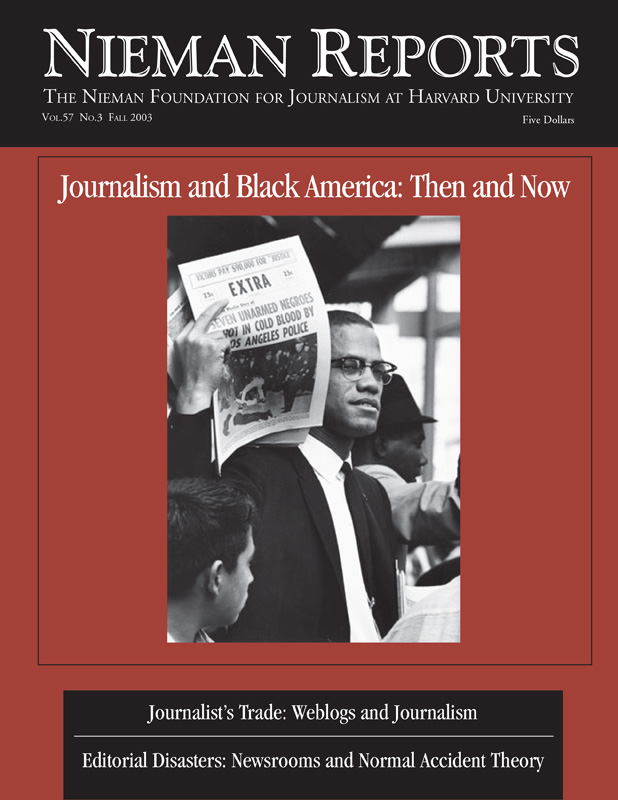On July 16, 2003, a burgundy Buick LeSabre drove through the Santa Monica Farmer’s Market at 60 miles an hour. The 85-year-old driver killed 10 people and injured scores of other shoppers. Within minutes of the accident, reporters from newspapers, radio and TV stations were rushing to the scene. But if they were hoping for a scoop, they were already too late. That’s because a blogger named Andy Baio (www.waxy.org) had already blogged the entire incident.
Baio’s office, where he manages the Web site staff of a large investment firm, is located beside the Farmer’s Market, and he saw the event unfold from his window. Even though Baio isn’t a journalist (or is he?), he did what any good journalist would do. He reported what he saw. He also took advantage of his medium and included a map of the area and, as photos and film began to appear on other Web sites, he provided links to fresh coverage.
Throughout the day, often in a personal way, Baio described the scene of carnage outside his office. Almost as affecting (and totally missed by the body-count-driven traditional media) is his description of how quickly life came back to normal on the following day, as vendors quickly set up shop again. And then at the bottom of his blog, Baio allowed his readers to post comments on what had happened. What they posted added layers to the coverage of this story; as some people raged against the elderly driver, others debated at what age should people not be allowed to drive.
Weblogs Push Journalists
During the past year, Weblogs have risen to near the top of the media’s collective consciousness. There are several reasons for this awakening: More well-known journalists have started blogs in the past year, and Web sites of well-known media brands have created blogs to help cover news, politics and other issues. But more important to their ascendancy has been the fact that on at least two noteworthy occasions, Weblogs have forced traditional news organizations to change the way they covered a big story.
Perhaps the best known example is the untimely political demise of former Republican Senate majority leader Trent Lott. When Lott first made his now well-known comments about how the country would have been better off if voters had elected then segregationist presidential candidate Senator Strom Thurmond in 1948, not a single media outlet picked up on the significance of the remarks, even though plenty of reporters were there to hear him say it. Thus, the job of reporting this story was left to bloggers, who kept the story alive for days until the mainstream media woke up to what had happened.
RELATED ARTICLE
“Weblogs and Journalism: Back to the Future?”
– Glenn Harlan ReynoldsThe second example involves the resignation of New York Times’s excutive editor Howell Raines. For a while, it looked as if Raines might survive the Jayson Blair scandal. But political blogs such as Andrew Sullivan and Glenn Reynolds (at www.Instapundit.com) again refused to let the issue die. While the bloggers’ ongoing postings about Raines were not the only factor that led to his dismissal, they played a role.
With this kind of track record, wouldn’t journalists welcome bloggers with open arms? Instead, many journalists tend to regard bloggers as a sort of mutant breed, viewing them with skepticism and suspicion. In the eyes of many journalists, blogs are poorly written, self-absorbed, hyper-opinionated, and done by amateurs. At the same time it’s true that blogs are often crammed with blunt and sarcastic comments about what a poor job journalists are doing, with bloggers calling journalists’ work stagnant, hyper-elitist, and arguing that they spend too much time writing for each other rather than for the public.
Who’s right and who’s wrong? They both are.
Blogs are quickly becoming a very influential media tool, one that can challenge conventional notions of who is a journalist and what journalism is. But if bloggers are to continue to help shape the political, cultural and media arenas, they will need to adopt some of journalism’s practices that they now eschew, often because of laziness.
Creativity at the Edge
To better understand why journalists often hide their fear of bloggers behind masks of professional indifference, turn to Michael Lewis’s “The Future Just Happened.” Lewis explores how technology, and the Internet in particular, has created dramatic upheavals in three worlds that previously existed with rigid codes and were ruled by a kind of “priesthood”: Wall Street, law and the music business.
Two important lessons can be gleaned from what Lewis discovered: Creativity almost always happens at the edges of society, not in the center, and the one thing the Internet does more than anything else is to allow small groups or individuals to undermine elites. In Lewis’s book, he showed several examples of how these quite powerful institutions found themselves on the defensive because “untrained” people outside the traditional circles of power—and who were often bored high school or college students—were able to duplicate or surpass the services they offered.
Weblogs now present a similar threat to traditional media. This threat—to the gatekeeper role that big news organizations have played—represents a more immediate challenge than the large-scale introduction of the Internet did during the mid-1990’s. Back then, the fear was that the Internet would take away huge chunks of readers and audience from traditional media. (That hasn’t really happened yet, but it will during the next two decades as the Internet generation ages.) What skillful bloggers are demonstrating to traditional media is how they no longer get to decide on their own what is news anymore. In the case of Senator Lott, for example, traditional media seemed to decide his comments weren’t newsworthy. Without blogs and the Internet, it is likely that decision would have ended the story. But bloggers didn’t share that news judgment and so they kept pounding on his remarks as insensitive, if not outright racist. The bloggers were right.
Blogs also threaten to expose journalism at one of its weakest points—its lack of personal contact with readers and audience and the sense that journalism and its practitioners are disconnected from the communities they are supposed to serve. As young people begin to be interested in the news, they are finding that blogs can be a better place to keep up with events than their local or national media outlets. And unlike so many cities and towns in America, where there might be one newspaper (most likely owned by a chain), and where the local radio and TV stations have little, if any, variety of programming or opinion, a person can find dozens of informative blogs by people of every political persuasion. Two or three good blogs can often provide a richer and more varied picture of an event than all the TV news outlets, cable and broadcast, put together.
But bloggers have problems that often undermine their credibility. Too many are poorly written, and bloggers often defend this tendency by saying it shows the realism of their work. At a recent conference on blogging in Boston, Dave Weinberger, one of the real founders of blogging and author of “The Cluetrain Manifesto,” described it this way: “As rhetoric, I think it’s important that it [a blog] is written badly. It’s daily. You have a sense that it’s closer to the person’s authentic self. By reading a first draft, you tend to be ‘forgiven’ by the readers for the mistakes you make.”
Nonsense. While forgiveness might occur the first time a reader visits a blog, the experience wears thin fast. While most readers will overlook a typo or two in a piece (many won’t, by the way), if mistakes repeatedly show up, they undermine the writer’s credibility. Bloggers might not want to admit this, but neatness counts in the long run.
Accuracy counts, too. But bloggers promise a more immediate experience of the news, one in which accuracy isn’t regarded by the blogger as being the most important element. Sometimes this works, especially on a breaking news piece, creating a kind of unfolding drama, as happened with the Santa Monica market tragedy. But if accuracy is sacrificed too often, or if a blogger brushes it off as inconsequential, audiences will drift away. People want reliable news sources, even very personal ones, they can trust.
Then there is the prickly question of editing, viewed by many bloggers as the equivalent of death by Chinese water torture. Editing, they argue, undermines the experience of the blog and interrupts the writer’s flow of thoughts and words. Editing does all these things, but truthfully sometimes it’s not so bad for a writer’s thoughts to be interrupted. This posture also exposes a basic conceit of bloggers—the belief (or hope) that everybody reads what they’ve posted as soon as they post it, which, of course, doesn’t happen. So this means that more than a few bloggers would benefit from taking a second look at what they are about to post or having a second set of eyes give it a quick read.
At The Christian Science Monitor, our blogs are edited, often by two or three people, before they are posted. I have no doubt this editing process improves the quality of the blog without sacrificing its freshness. If the feedback we’ve received from our readers is any indication, they believe this as well. Adapting the role of an editor to the blogging situation seems an example of how traditional media and bloggers can learn from each other. And when they are willing to do this, then the work of each will be improved.
The Best of Both Worlds
RELATED ARTICLES
“Readers Glimpse an Editorial Board’s Thinking”
– Keven Ann Willey
“Blogs and Journalism Need Each Other”
– J.D. LasicaSome media organizations believe that blogs can be an important part of their overall news package. Each day at the Monitor, our Daily Update blog on the war on terrorism and in Iraq is regularly among the top five most read pieces on our Web site. Meanwhile, The Dallas Morning News has decided to create an editorial blog where editorial writers can shed light on how they—as individuals and as a board—arrive at the opinions they publish. As J.D. Lasica wrote in the Online News listserv, this accomplishes several things: It adds transparency to the usually hidden editorial opinion process, frees editorial writers to write in a more lively and personal fashion, and lets the public see that the paper’s editorial board isn’t monolithic.
Other news organizations are experimenting with the idea of allowing their writers to do blogs as a supplement to their regular reporting, but it’s still a learning process. While editing is a useful way to improve the quality of a blog, overediting a blog will kill its sense of voice and community. Learning to let go is going to be very difficult for a lot of editors who are used to an almost Stalinesque control over their writers’ output and the way that output is presented to the public.
Meanwhile, the rest of us in traditional journalism, especially those who care deeply about what’s happening to the media, can be thankful that bloggers exist. At a time when media control is more concentrated and when presenting “fair and balanced news” can be just another way to limit voices and disguise a corporate or political agenda, bloggers are the dam-busters of the media world. Long may they blow open holes in the gatekeepers’ firewalls so that all the voices that are being ignored or silenced can find ways to be heard.
Tom Regan, a 1992 Nieman Fellow, is associate editor of csmonitor.com, the Web site of The Christian Science Monitor. Regan cowrites two Monitor blogs: Daily Update, a blog about the war on terrorism and in Iraq, and SciTechblog, about science and technology.



